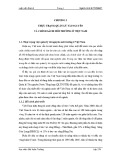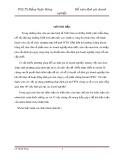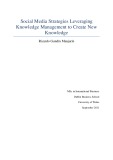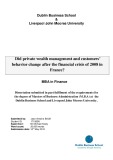
MINISTRY OF EDUCATION STATE BANK OF VIETNAM
BANKING UNIVERSITY, HO CHI MINH CITY
NGUYEN LUU TUYEN
THE IMPACT OF BANK COMPETITION TO
FINANCIAL STABILITY OF VIETNAM
COMMERCIAL BANK
DOCTOR OF PHILOSOPHY IN ECONOMICS
THESIS SUMMARY
Major: Finance – Banking
Code : 62.34.02.01
Instructors: Doctor. Lam Thi Hong Hoa
Doctor. Le Ho An Chau
HO CHI MINH CITY - 2018

1
CHAPTER 1: GENERAL INTRODUCTION
1.1. Practical context and reasons for choosing the topic
Improving domestic and international competitiveness while ensuring the
financial stability of the commercial banking system in Vietnam is one of the
important objectives of Vietnam's banking and finance industry during 2011 - 2016.
Over the past few years, the mergers, acquisitions and restructuring of banks'
operations have been extremely active, under the scheme "Restructuring Credit
Institutions (CIs) in 2011-2015" approved by the Prime Minister on 01/03/2012,
with priority given to weak credit institutions; to carry out the merger, consolidation
and acquisition of CIs on the principle of voluntariness; to increase chartered capital
and handle bad debts of credit institutions and step by step restructure operation,
management and administration. This resulted in a reduction in the number of banks
in the system when weak banks were forced to merge. The mergers and acquisitions
of commercial banks also raised concerns about the possibility of a decline in the
competitiveness of the banking industry and the impact on the financial stability of
Vietnam commercial banks.
In the context of Vietnam joining the ASEAN Economic Community (AEC)
by 2015, or the signing of important FTAs between Vietnam / ASEAN with India,
Japan, South Korea , Australia & New Zealand, Chile, Eurasia, the trend as well as
the requirement to improve the competitiveness of commercial banks in Vietnam
and ensure the financial stability of commercial banks is one of the Important
factors support this process.
Trends and requirements to improve competition and financial stability of
commercial banks are increasingly interested in different markets and is the subject
of many debates.
In recent years there have been several debates regarding the relationship
between competition and the stability of the banking system (Beck, 2008; Carletti,
2008). The debates on this relationship have formed two contradictory views:
"competition-fragility" and "competition-stability". From the standpoint of

2
"competition -fragility", increasing bank competition reduces the marketpower,
ank's profit margins and consequently decreases the franchisevalue of the bank
(Berger et al., 2009). This encourages banks to take more risks to seek profits,
causing instability in the banking system (Marcus, 1984; Keeley, 1990; Carletti and
Hartmann, 2003).
In contrast, the "competition – stability" view holds that there is a positive
relationship between banking competition and the stability of the banking system.
Increased competition will lead to the stability of the banking system and vice versa
(Xiaoqing (Maggie) Fu et al., 2014). In a market where competition between banks
is low, it can be more risky when large banks are often considered too important to
fail and thus, when faced with difficulties in operating, those banks usually receive
support from the government (Mishkin, 1999). In addition, in a low-competition
market, large market-power banks will offer higher lending rates, which will cause
difficulties for borrowers in repayment capacity and increase the risk exposure of
the bank (Xiaoqing (Maggie) Fu et al., 2014). In contrast, in a market where
competition among banks is high, lending rates are low; problems of“too-big-to
fail”receiveless attention, and therefore positively impact on the stability of the
banking system (Boyd and De Nicoló, 2005; Beck, 2006; Schaeck, 2006; Turk-
Ariss, 2010).
Studies supporting these two points suggest that the effects of competition on
the stability of the banking system are inconsistent across countries. In addition,
very few studies examine the relationship between competition and stability before
and after the financial crisis (Fu et al, 2014; Boyd and De Nicoló, 2005; Beck,
2006; Schaeck, 2006; Turk-Ariss, 2010).
Therefore this research is necessary to strengthen the practical evidences and
theoretical foundation of the relationship between competition and stability of
Vietnam commercial banks. This study aims to assess the relationship between
competition and stability of the Vietnam commercial banks for updated period from

3
2008 - 2016. This study also looks at this relationship in the context of the financial
crisis of 2008 and 2009.
Research results will also provide a basis for policy makers and stakeholders
to better understand the impact of competition on the financial stability of
commercial banks to set out approriate strategies and solutions.
1.2. Research objectives and research questions:
Research objectives:
The overall objective of the thesis is to study the impact of competition on
the financial stability of Vietnamese commercial banks by examining the
relationship between "competitive - stable" and "competitive - fragile". From the
results of the study, the thesis will discuss the appropriate policy implications.
To achieve the overall goal, the thesis will in turn address three specific
objectives:
• Measuring the level of competition and analyzing factors affecting the
competition of Vietnamese commercial banks.
• Measuring financial stability and analysis of factors affecting the financial
stability of Vietnamese commercial banks.
• Examine the impact of competition on the financial stability of Vietnamese
commercial banks by testing two hypotheses: "competition - stability" and
"competition - fragility".
Research questions:
To achieve the research objectives, the thesis responds to the following
research questions:
• What are the level of competition of Vietnam commercial banks in 2008-
2016?
• What factors affect the level of competition of Vietnam commercial banks?
• What are the level of financial stability of Vietnam commercial banks in
2008-2016?

4
• What factors affect the financial stability of Vietnam commercial banks?
• The impact of competition on financial stability of Vietnam commercial
banks supports the "competition-stability" or "competitive-fragility"
hypothesis?
1.3. Research Object and research scope:
• Research object: The object of the study is the impact of competition on
financial stability of commercial banks. In particular, the degree of
competition represented by the Lener index and the financial stability is
represented by the bank's bankruptcy risk level, Z-score, based on relevant
theoretical background and research.
• Research scope: Limited in 24 joint stock commercial banks in Vietnam.
The study period is from 2008 to 2016.
1.4. Recearch methodology:
Based on the financial report, annual report, public documents of commercial
banks in Vietnam from 2008 to 2016, the Lerner Competitiveness Index was
calculated according to Abba Lerner's formula (1934) to estimate and compare the
level of competition of Vietnamese commercial banks in the period 2008 - 2016.
Subsequently, the thesis inherited the Z-score calculation method for banks used in
the research of Boyd & Graham (1986 ), Hannan & Hanweck (1988), Boyd & ctg
(1993) to measure the financial stability of Vietnamese commercial banks. The
study then uses models proposed by Raúl Osvaldo Fernández et al (2015) to test the
relationship between competition and financial stability of Vietnamese commercial
banks. To overcome the endogenous phenomena in the model, the thesis utilizes the
tool change technique with the DGMM estimation, seeking evidence of the impact
of competition on the financial stability of Vietnamese commercial banks in normal
conditions and in crisis conditions.


























